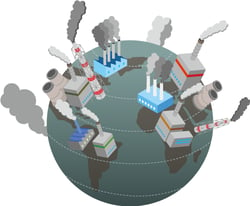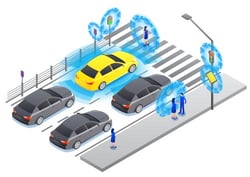 In the dynamic landscape of automotive manufacturing, product roadmapping software is a crucial tool for innovation and success. However, it has its challenges. From rapid technological advancements to market demands, automotive manufacturers must navigate a complex web of factors to make successful products, and roadmaps can help make it happen.
In the dynamic landscape of automotive manufacturing, product roadmapping software is a crucial tool for innovation and success. However, it has its challenges. From rapid technological advancements to market demands, automotive manufacturers must navigate a complex web of factors to make successful products, and roadmaps can help make it happen.
In this article, we'll explore the top ten frequent challenges automotive manufacturers encounter in product development and how roadmapping makes it easier. These challenges reflect the industry's multifaceted nature and the need for manufacturers to adapt and innovate continuously. By understanding these challenges, manufacturers can better prepare themselves to overcome obstacles and steer their products toward success.
Aligning Goals
 Manufacturing companies set important goals, but communicating those goals to their expansive teams takes time. How can executives ensure that every team at all levels of the organization understands the bigger goals and helps work towards them? One method of informing teams is to ensure product leaders identify the goals and prioritize the products that lead to those goals. Product leaders can set and share key metric targets that support the goals and keep them top of mind during idea stages and prioritization.
Manufacturing companies set important goals, but communicating those goals to their expansive teams takes time. How can executives ensure that every team at all levels of the organization understands the bigger goals and helps work towards them? One method of informing teams is to ensure product leaders identify the goals and prioritize the products that lead to those goals. Product leaders can set and share key metric targets that support the goals and keep them top of mind during idea stages and prioritization.
The Takeaway: The product roadmap is a tool to communicate company goals and keep teams in alignment.
Achieving ESG targets
 Most manufacturing companies are under societal pressure to adopt best practices in the areas of the environment, social responsibility, and governance. For this reason and the desire to make a positive impact on the world, companies are increasingly setting Environmental, Social, and Governance (ESG) goals.
Most manufacturing companies are under societal pressure to adopt best practices in the areas of the environment, social responsibility, and governance. For this reason and the desire to make a positive impact on the world, companies are increasingly setting Environmental, Social, and Governance (ESG) goals.
With increasing awareness of environmental issues, automotive manufacturers are particularly under pressure to reduce their carbon footprint in their operations and products. This involves producing greener vehicles and adopting sustainable practices in manufacturing processes and supply chain operations. But once a company sets these goals, how do they track them? The product roadmap is an excellent place to start by identifying which models contribute to these goals and where greater opportunities lie.
The Takeaway: Product roadmaps help manufacturing companies set and track ESG goals across their entire portfolio.
Managing Market Uncertainty
 Staying ahead of the competition and meeting customer demands in automotive manufacturing requires dynamic product roadmapping. The best way to accomplish this is to hold regular customer feedback sessions, continuously analyze the market, and evaluate the product portfolio. These essential practices help make product planning adaptable where feasible and are especially important with lengthy product development timelines, where numerous changes in the market and consumer demands can happen.
Staying ahead of the competition and meeting customer demands in automotive manufacturing requires dynamic product roadmapping. The best way to accomplish this is to hold regular customer feedback sessions, continuously analyze the market, and evaluate the product portfolio. These essential practices help make product planning adaptable where feasible and are especially important with lengthy product development timelines, where numerous changes in the market and consumer demands can happen.
The Takeaway: Dynamic product roadmapping makes managing uncertainty in the market easier.
Balancing Customer Demand vs. Deliverability
 Consumer demands evolve rapidly, driven by factors like sustainability, safety, and convenience. Meeting these expectations requires manufacturers to innovate while balancing customer demand with deliverability. In some cases, customer demand can be a fleeting trend, while at other times, it's a shift that stays. Companies must decipher which demands are worth pursuing, such as more eco-friendly vehicles, advanced driver-assistance systems (ADAS), and seamless connectivity.
Consumer demands evolve rapidly, driven by factors like sustainability, safety, and convenience. Meeting these expectations requires manufacturers to innovate while balancing customer demand with deliverability. In some cases, customer demand can be a fleeting trend, while at other times, it's a shift that stays. Companies must decipher which demands are worth pursuing, such as more eco-friendly vehicles, advanced driver-assistance systems (ADAS), and seamless connectivity.
The Takeaway: Product teams can track features in the roadmap for each product to determine which ones perform better than others. When market analysis is also captured on the roadmap, product teams can look at the big picture each time they need to make decisions.
Managing Long Timelines
The product development timeline of a vehicle can span several years compared to the relatively compact timelines of software development, which can span months of build time before the launch dates. Lengthier timelines require more detailed planning while allowing flexibility to adapt to technological leaps and advancements that may happen during the process.
The Takeaway: Dynamic manufacturing product roadmaps are essential to planning out the long production process for vehicles and following through on each phase of development.
Integrating Technology
 With the rise of electric vehicles (EVs), autonomous driving, and connected cars, integrating new technologies into existing production lines presents a significant challenge. It's one thing to set the goal on a roadmap and an entirely different challenge to follow through and make it happen. Manufacturers must invest in R&D to stay current with trends and innovate unique advancements that set them apart. They may also need to retrain their staff or revamp infrastructure to adapt to these changes.
With the rise of electric vehicles (EVs), autonomous driving, and connected cars, integrating new technologies into existing production lines presents a significant challenge. It's one thing to set the goal on a roadmap and an entirely different challenge to follow through and make it happen. Manufacturers must invest in R&D to stay current with trends and innovate unique advancements that set them apart. They may also need to retrain their staff or revamp infrastructure to adapt to these changes.
The Takeaway: Product roadmaps are the central hub for everything related to each product in the portfolio. When a new piece of technology is ready to phase into production, or an older technology is slated to phase out, it needs to be communicated on the roadmap so all product teams know what's available to them and what isn't.
Syncing Cadences
We mentioned how software development operates on shorter timelines while the physical vehicle components take multiple years. The challenge then becomes syncing these two timelines together to ensure the hardware is ready when the software portion is. Syncing the cadences requires cross-collaboration between engineering teams, production managers, and software teams to set realistic deadlines that keep the entire project on track to hit the key milestones.
The Takeaway: The roadmap is essential to sync timelines between software and hardware teams.
Prioritizing Ideas
 Managing product ideas requires a system to know which ones are worth pursuing and when. Companies often use a scoring formula to evaluate each suggestion and narrow down the choices to those that align with goals, support the business and will make a difference with customers. While prioritization discussions can be lengthy and convoluted, product roadmap software can make them simpler with automatic scoring formulas and drag-and-drop dashboards. Scoring product ideas gives clarity to the discussion and helps product leaders choose the right focus.
Managing product ideas requires a system to know which ones are worth pursuing and when. Companies often use a scoring formula to evaluate each suggestion and narrow down the choices to those that align with goals, support the business and will make a difference with customers. While prioritization discussions can be lengthy and convoluted, product roadmap software can make them simpler with automatic scoring formulas and drag-and-drop dashboards. Scoring product ideas gives clarity to the discussion and helps product leaders choose the right focus.
The Takeaway: Scoring and prioritizing product features using product roadmap management software makes it easier to manage suggestions and choose the next focus.
Maintaining Open Communication
The complexity of product development, especially vehicle plans, requires transparent, open communication systems to ensure all stakeholders are informed. Multiple teams need to know the latest updates, challenges, and product changes. There are many communication elements among manufacturing teams. The best place to share details on product development is on the product roadmaps, using product roadmap management software.
Collaborations become more effective when all stakeholders can view the roadmap to see alerts and notifications of updates or problems. Open, transparent communication can also lead to greater innovation and problem-solving.
The Takeaway: Open communication is possible when product teams use product roadmap management software to keep all stakeholders informed and connected.
Managing the Product Roadmaps
Automotive manufacturing requires robust roadmapping tools to keep all teams informed, up-to-date, and collaborating. It also requires oversight of product lines and full product portfolios. With so many moving pieces, it's essential to use product roadmap management software that keeps teams connected and provides high-level oversight so everyone, from product executives to product managers, can find the necessary details.
The Takeaway: Gocious product roadmap management software gives automotive manufacturers the high-level details and cross-collaborative tools necessary to stay informed.
Product Roadmap Software for Automotive Manufacturers
Gocious product roadmap software is built for complex product portfolios. Book your free demo to see how it can work for your manufacturing team.


